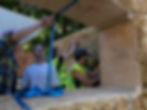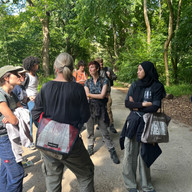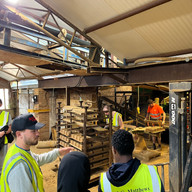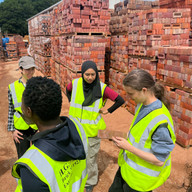A report on our Regenerative Community Building workshops
- josh51992
- Jul 24
- 3 min read

In June, a total of 21 participants from a wide range of backgrounds joined us for our Regenerative Community Building workshops, run in collaboration with Material Cultures. These three 2-day workshops were designed to explore how local community members can build affordable housing using natural materials that are both produced regeneratively and sourced locally (see below for more on what this means, and why it's important).
The workshops took in visits to local sites of material production – from forests to a brick factory, alkaline fenland to a hemp farm – and saw participants getting their hands (and feet!) stuck into the tactile and immensely satisfying process of building with minimally-processed materials.
We were joined by expert facilitators Jez Ralph (Evolving Forests) and Olly Moses, who taught us how to create timber shakes from freshly-cut logs that will repel and withstand the worst of the British rain, without the need for additional coatings; Annabel Cameron-Duff (The Roundhouse Company), who taught us how to test soil for its clay content, and create and apply a wonderfully breathable and resilient plaster that will regulate the moisture in our homes; and Barbara Jones (The School of Natural Building) and Francesca Leibowitz, who taught us how one of our most abundant agricultural waste materials, wheat straw, can be used to build highly-insulated and structurally sound homes at a fraction of the price of conventional homes, and at speed.
Feedback from participants, collected by our partners at Oxford and Oxford Brookes universities as part of Oxford University’s Science Together programme, was overwhelmingly positive – in short, people learnt a lot and had a lot of fun while doing so – and we now have a pool of people who are keen to take forward the skills and ideas we explored in the workshops.
Scroll down for pictures of the workshops, which you can also see on our project instagram page here.
We're very grateful to Oxford University and CAG Oxfordshire, who provided funding for the workshops; to Unity Lime and AW Mobbs for donating materials; to the Cutteslowe Minibus for transporting us free of charge; and last but by no means least to Makespace for hosting us. We'd also like to thank our wonderful SDG Community Impact Lab fellows Charlotte and Shalini, who helped with the research around the project.
Why did we run these workshops?
Our workshops focused on building with three materials:
Workshop 1: Timber, specifically making timber shakes to clad buildings (external cladding)
Workshop 2: Clay, specifically making and using clay plaster (internal plaster)
Workshop 3: Straw, specifically building with straw bales (walls – structure & insulation)
All three are ways of building regeneratively that can be – and have been – used to create affordable housing. For example, Ash Sakula's award-winning affordable housing in Hampshire (timber cladding); the Lilac affordable cohousing project in Leeds (straw bale); and Agile’s affordable homes (which use clay plaster for internal finishes). And all of these materials are increasingly being used by companies developing modular MMC, such as Ecococon – whose product we worked with in the workshops – Blokbuild, and Natural Building Systems.
Why we focused on these materials
all are either very low-carbon or actually carbon-negative (because they sequester carbon in buildings)
This means buildings that use these materials are likely to be eligible now for investment through carbon capture credit schemes like the one Agile Homes just set up
they all help create healthy buildings, regulating temperature and humidity, and obviating the need for materials that emit and/or trap noxious gases inside our homes
they can be grown / extracted in a way that enables the natural environment to regenerate rather than degrading it
This means buildings that use them may in future be eligible for investment targeting biodiversity net gain
and they are comparatively quick, easy and safe to learn to use, which means a broad cross-section of the community can come together to build with them, boosting cohesion, solidarity, sense of agency etc., and upskilling people in valuable (green) skills for the future at the same time!
This means buildings built in this way are likely to be eligible for social-value impact investment
To find out more about the project out of which these workshops emerged, and the reasons why we believe it's important, see our longer article here.
How can I get involved?
We're planning to continue the project that led to these workshops over the next year, subject to funding, and we hope this will allow us to run more workshops in the near future. If you're interested in this way of building, and would like to find out more, please follow our dedicated project instagram account and/or email Josh (josh@oclt.org.uk) for more details.








































































